gas type TOYOTA RAV4 HYBRID 2020 Owners Manual (in English)
[x] Cancel search | Manufacturer: TOYOTA, Model Year: 2020, Model line: RAV4 HYBRID, Model: TOYOTA RAV4 HYBRID 2020Pages: 748, PDF Size: 30.6 MB
Page 241 of 748

2414-4. Refueling
4
Driving
4-4.Refueling
’ü¼Close all the doors and win-
dows, and turn the power
switch to OFF.
’ü¼ Confirm the type of fuel.
Ō¢ĀFuel types
’é« P.688
Ō¢ĀFuel tank opening for unleaded
gasoline
To help prevent incorrect fueling,
your vehicle has a fuel tank opening
that only acco mmodates the spe-
cial nozzle on unleaded fuel pumps.
Opening the fuel tank
cap
The fuel tank of your vehicle
has a special structure,
which requires a reduction
in fuel tank pressure before
refueling. After the opener
switch has been pressed, it
will take several seconds
until the vehicle is ready for
refueling.
Before refueling the vehi-
cle
WARNING
Ō¢ĀWhen refueling the vehicle
Observe the following precautions
while refueling the vehicle. Failure
to do so may result in death or
serious injury.
ŌŚÅAfter exiting the vehicle and
before opening the fuel door,
touch an unpainted metal sur-
face to discharge any static
electricity. It is important to dis-
charge static electricity before
refueling because sparks result-
ing from static electricity can
cause fuel vapors to ignite while
refueling.
ŌŚÅAlways hold the grips on the
fuel tank cap and turn it slowly
to remove it.
A whooshing sound may be
heard when the f uel tank cap is
loosened. Wait until the sound
cannot be heard before fully
removing the cap. In hot
weather, pressurized fuel may
spray out of the filler neck and
cause injury.
ŌŚÅDo not allow anyone that has
not discharged static electricity
from their body to come close to
an open fuel tank.
ŌŚÅDo not inhale vaporized fuel.
Fuel contains substances that
are harmful if inhaled.
ŌŚÅDo not smoke while refueling
the vehicle.
Doing so may cause the fuel to
ignite and cause a fire.
ŌŚÅDo not return to the vehicle or
touch any person or object that
is statically charged. This may
cause static electricity to build
up, resulting in a possible igni-
tion hazard.
Page 568 of 748

5687-1. Maintenance and care
’ü¼Remove dirt and dust using a
vacuum cleaner.
’ü¼ Wipe off any excess dirt and
dust with a soft cloth damp-
ened with diluted detergent.
Use a diluted water solution of
approximately 5% neutral wool
detergent.
’ü¼Wring out any excess water
from the cloth and thoroughly
wipe off all remaining traces
of detergent.
NOTICE
Ō¢ĀCleaning detergents
ŌŚÅDo not use the f ollowing types
of detergent, as they may dis-
color the vehicle interior or
cause streaks or damage to
painted surfaces:
ŌĆó Non-seat portions: Organic sub- stances such as benzene or
gasoline, alkaline or acidic solu-
tions, dye, and bleach
ŌĆó Seats: Alkaline or acidic solu- tions, such as thinner, benzene,
and alcohol
ŌŚÅDo not use a polish wax or pol-
ish cleaner. The instrument
panelŌĆÖs or other interior partŌĆÖs
painted surface may be dam-
aged.
Ō¢ĀPreventing damage to leather
surfaces
Observe the following precautions
to avoid damage to and deteriora-
tion of leather surfaces:
ŌŚÅRemove any dust or dirt from
leather surfaces immediately.
ŌŚÅDo not expose the vehicle to
direct sunlight for extended peri-
ods of time. Park the vehicle in
the shade, especially during
summer.
ŌŚÅDo not place items made of
vinyl, plastic, or containing wax
on the upholstery, as they may
stick to the leather surface if the
vehicle interior heats up signifi-
cantly.
Ō¢ĀWater on the floor
Do not wash the v ehicle floor with
water.
Vehicle systems such as the
audio system may be damaged if
water comes into contact with
electrical components such as the
audio system abov e or under the
floor of the vehicle. Water may
also cause the body to rust.
Ō¢ĀWhen cleaning the inside of
the windshield
Do not allow glass cleaner to con-
tact the lens. Also, do not touch
the lens. ( ’é«P.244)
Ō¢ĀCleaning the inside of the rear
window
ŌŚÅDo not use a gla ss cleaner to
clean the rear window, as this
may cause damage to the rear
window defogger heater wires.
Use a cloth dampened with
lukewarm water to gently wipe
the window clean. Wipe the win-
dow in strokes running parallel
to the heater wires.
ŌŚÅBe careful not to scratch or
damage the heater wires.
Cleaning the leather areas
Page 669 of 748
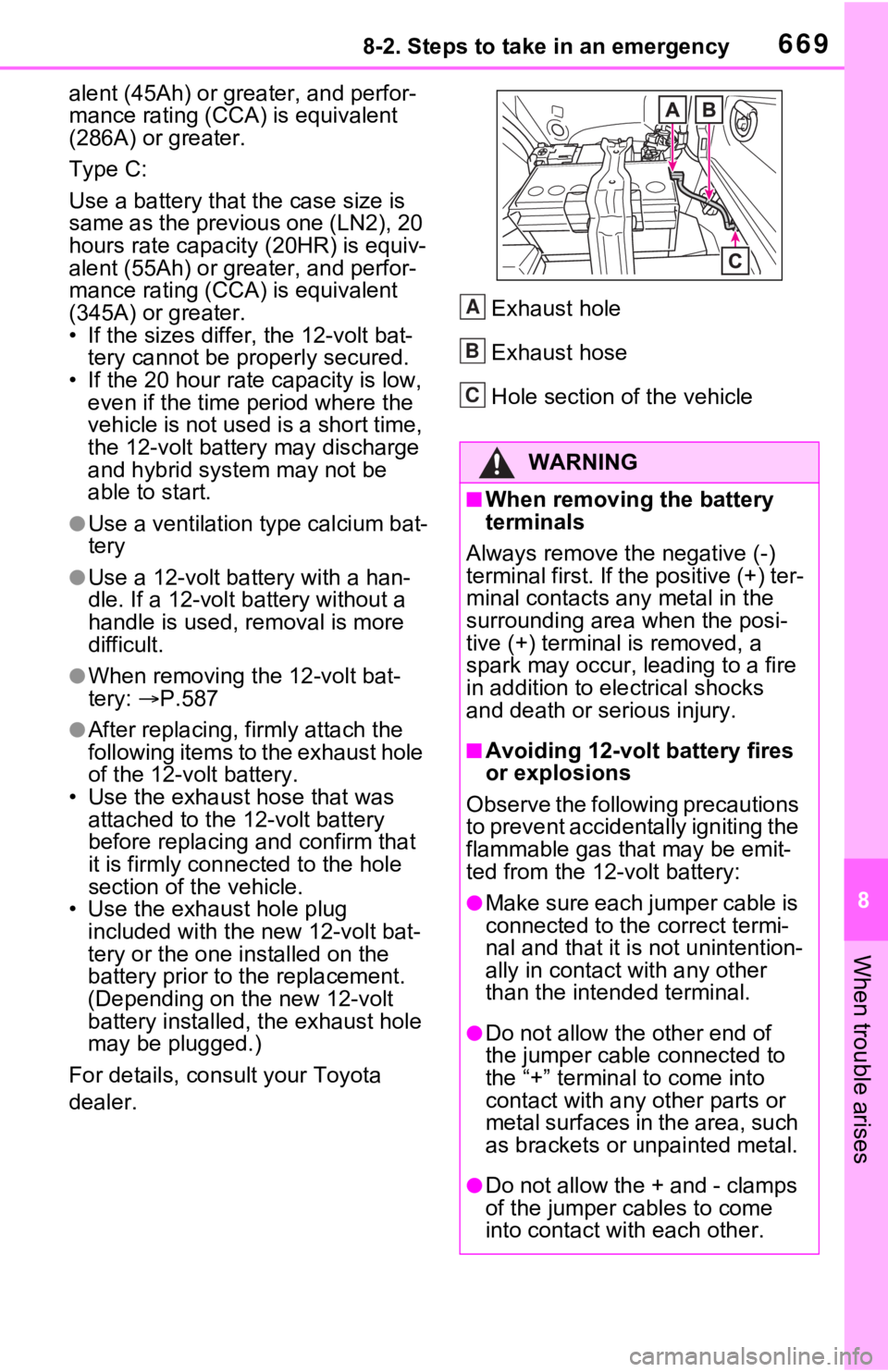
6698-2. Steps to take in an emergency
8
When trouble arises
alent (45Ah) or greater, and perfor-
mance rating (CCA) is equivalent
(286A) or greater.
Type C:
Use a battery that the case size is
same as the previous one (LN2), 20
hours rate capacity (20HR) is equiv-
alent (55Ah) or greater, and perfor-
mance rating (CCA) is equivalent
(345A) or greater.
ŌĆó If the sizes differ, the 12-volt bat-
tery cannot be pr operly secured.
ŌĆó If the 20 hour rate capacity is low,
even if the time period where the
vehicle is not used is a short time,
the 12-volt battery may discharge
and hybrid system may not be
able to start.
ŌŚÅUse a ventilation t ype calcium bat-
tery
ŌŚÅUse a 12-volt battery with a han-
dle. If a 12-volt b attery without a
handle is used, removal is more
difficult.
ŌŚÅWhen removing the 12-volt bat-
tery: ’é« P.587
ŌŚÅAfter replacing, firmly attach the
following items to the exhaust hole
of the 12-volt battery.
ŌĆó Use the exhaust hose that was attached to the 12-volt battery
before replacing an d confirm that
it is firmly connected to the hole
section of t he vehicle.
ŌĆó Use the exhaust hole plug
included with the new 12-volt bat-
tery or the one installed on the
battery prior to t he replacement.
(Depending on the new 12-volt
battery installed, the exhaust hole
may be plugged.)
For details, consult your Toyota
dealer. Exhaust hole
Exhaust hose
Hole section of the vehicle
WARNING
Ō¢ĀWhen removing the battery
terminals
Always remove the negative (-)
terminal first. If the positive (+) ter-
minal contacts any metal in the
surrounding area when the posi-
tive (+) terminal is removed, a
spark may occur, leading to a fire
in addition to ele ctrical shocks
and death or serious injury.
Ō¢ĀAvoiding 12-volt battery fires
or explosions
Observe the following precautions
to prevent accidentally igniting the
flammable gas that may be emit-
ted from the 12-volt battery:
ŌŚÅMake sure each jumper cable is
connected to the correct termi-
nal and that it is not unintention-
ally in contact with any other
than the intended terminal.
ŌŚÅDo not allow the other end of
the jumper cable connected to
the ŌĆ£+ŌĆØ terminal to come into
contact with any other parts or
metal surfaces in the area, such
as brackets or unpainted metal.
ŌŚÅDo not allow the + and - clamps
of the jumper cables to come
into contact with each other.
A
B
C
Page 679 of 748
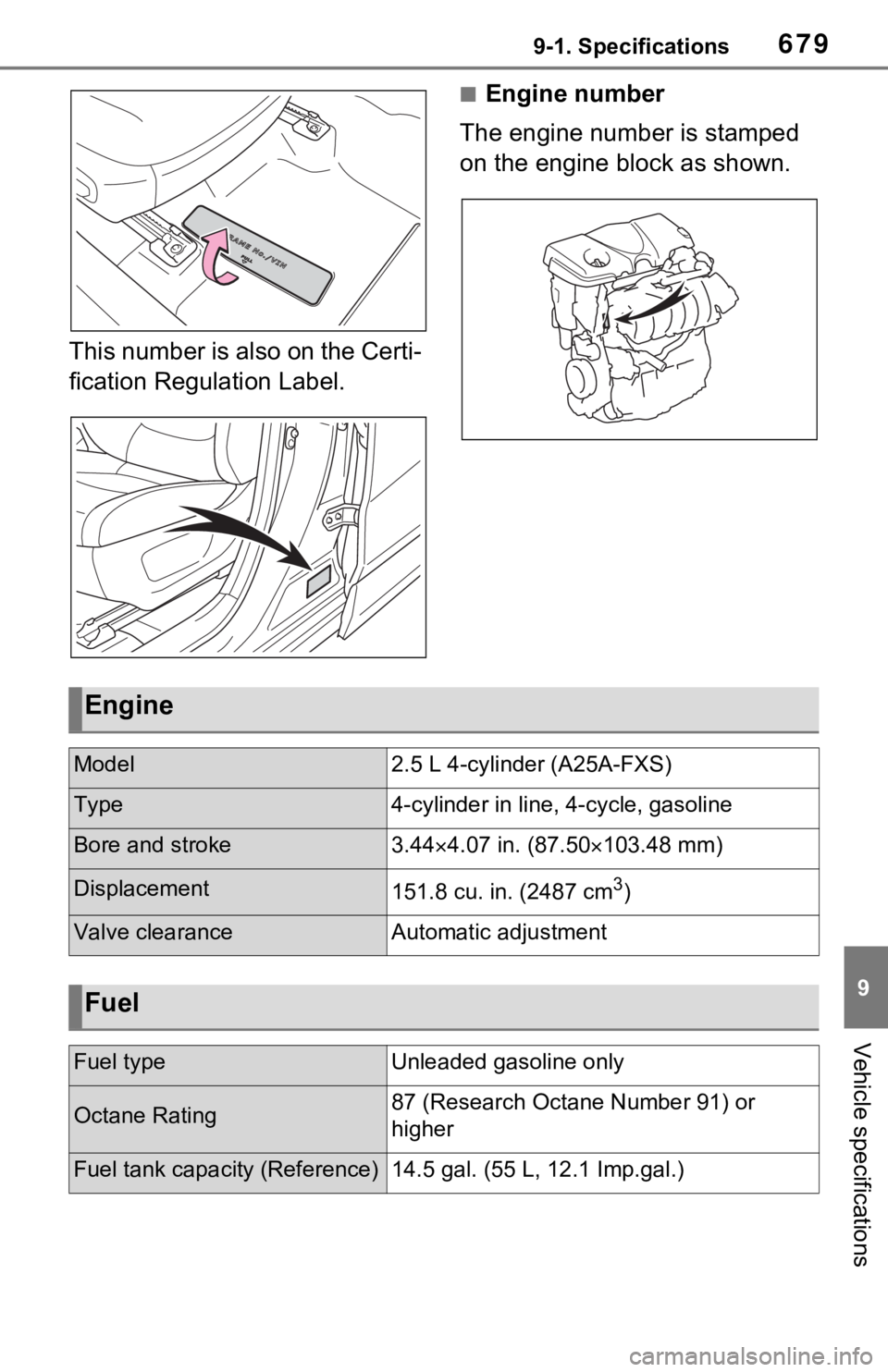
6799-1. Specifications
9
Vehicle specifications
This number is also on the Certi-
fication Regulation Label.
Ō¢ĀEngine number
The engine number is stamped
on the engine block as shown.
Engine
Model2.5 L 4-cylinder (A25A-FXS)
Type4-cylinder in line , 4-cycle, gasoline
Bore and stroke3.44’é┤4.07 in. (87.50 ’é┤103.48 mm)
Displacement151.8 cu. in. (2487 cm3)
Valve clearanceAutomatic adjustment
Fuel
Fuel typeUnleaded gasoline only
Octane Rating87 (Research Octane Number 91) or
higher
Fuel tank capacity (Reference)14.5 gal. (55 L, 12.1 Imp.gal.)
Page 682 of 748
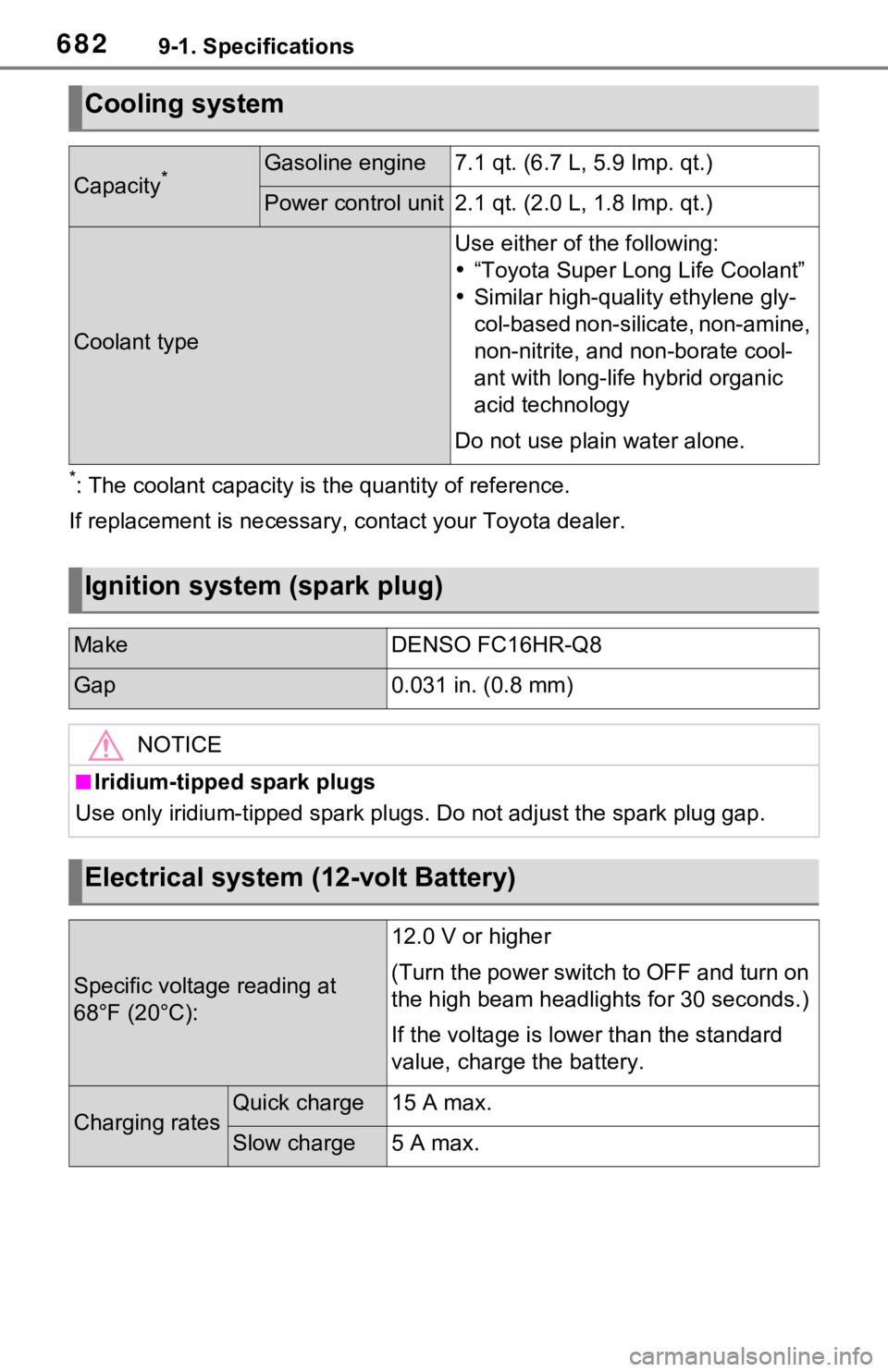
6829-1. Specifications
*: The coolant capacity is the quantity of reference.
If replacement is ne cessary, contact your Toyota dealer.
Cooling system
Capacity*Gasoline engine7.1 qt. (6.7 L, 5.9 Imp. qt.)
Power control unit2.1 qt. (2.0 L, 1.8 Imp. qt.)
Coolant type
Use either of the following:
’éĘŌĆ£Toyota Super Long Life CoolantŌĆØ
’éĘ Similar high-quality ethylene gly-
col-based non-silicate, non-amine,
non-nitrite, and non-borate cool-
ant with long-life hybrid organic
acid technology
Do not use plain water alone.
Ignition system (spark plug)
MakeDENSO FC16HR-Q8
Gap0.031 in. (0.8 mm)
NOTICE
Ō¢ĀIridium-tipped spark plugs
Use only iridium-tipped spark plugs. Do not adjust the spark pl ug gap.
Electrical system (12-volt Battery)
Specific voltage reading at
68┬░F (20┬░C):
12.0 V or higher
(Turn the power switch to OFF and turn on
the high beam headlights for 30 seconds.)
If the voltage is lower than the standard
value, charge the battery.
Charging ratesQuick charge15 A max.
Slow charge5 A max.
Page 689 of 748
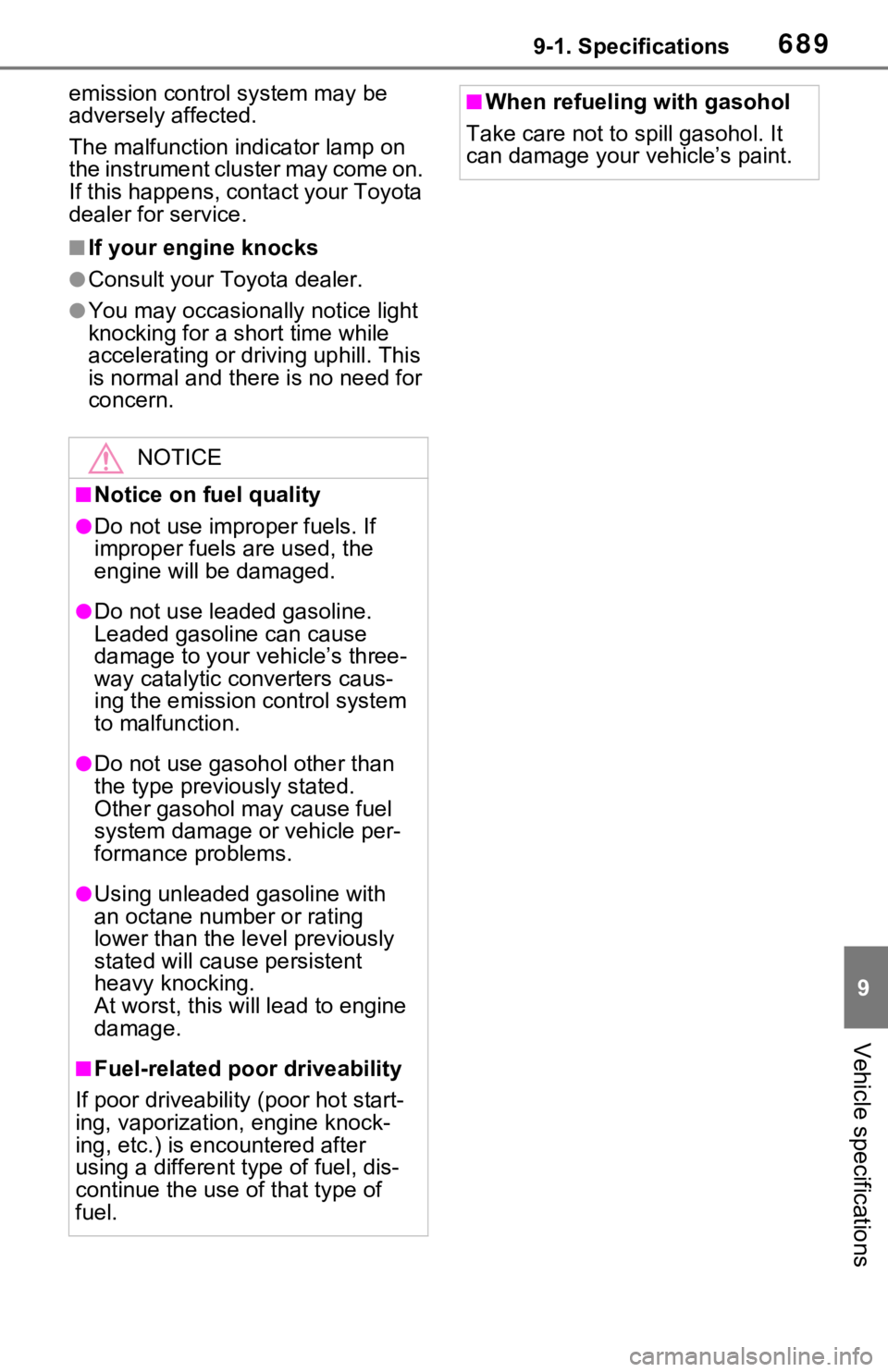
6899-1. Specifications
9
Vehicle specifications
emission control system may be
adversely affected.
The malfunction indicator lamp on
the instrument cluster may come on.
If this happens, contact your Toyota
dealer for service.
Ō¢ĀIf your engine knocks
ŌŚÅConsult your Toyota dealer.
ŌŚÅYou may occasionally notice light
knocking for a short time while
accelerating or driving uphill. This
is normal and there is no need for
concern.
NOTICE
Ō¢ĀNotice on fuel quality
ŌŚÅDo not use impro per fuels. If
improper fuels are used, the
engine will be damaged.
ŌŚÅDo not use leaded gasoline.
Leaded gasoline can cause
damage to your vehicleŌĆÖs three-
way catalytic converters caus-
ing the emission control system
to malfunction.
ŌŚÅDo not use gasohol other than
the type previously stated.
Other gasohol may cause fuel
system damage or vehicle per-
formance problems.
ŌŚÅUsing unleaded gasoline with
an octane number or rating
lower than the l evel previously
stated will cause persistent
heavy knocking.
At worst, this will lead to engine
damage.
Ō¢ĀFuel-related poor driveability
If poor driveability (poor hot start-
ing, vaporization, engine knock-
ing, etc.) is encountered after
using a different type of fuel, dis-
continue the use of that type of
fuel.
Ō¢ĀWhen refueling with gasohol
Take care not to s pill gasohol. It
can damage your vehicleŌĆÖs paint.
Page 734 of 748
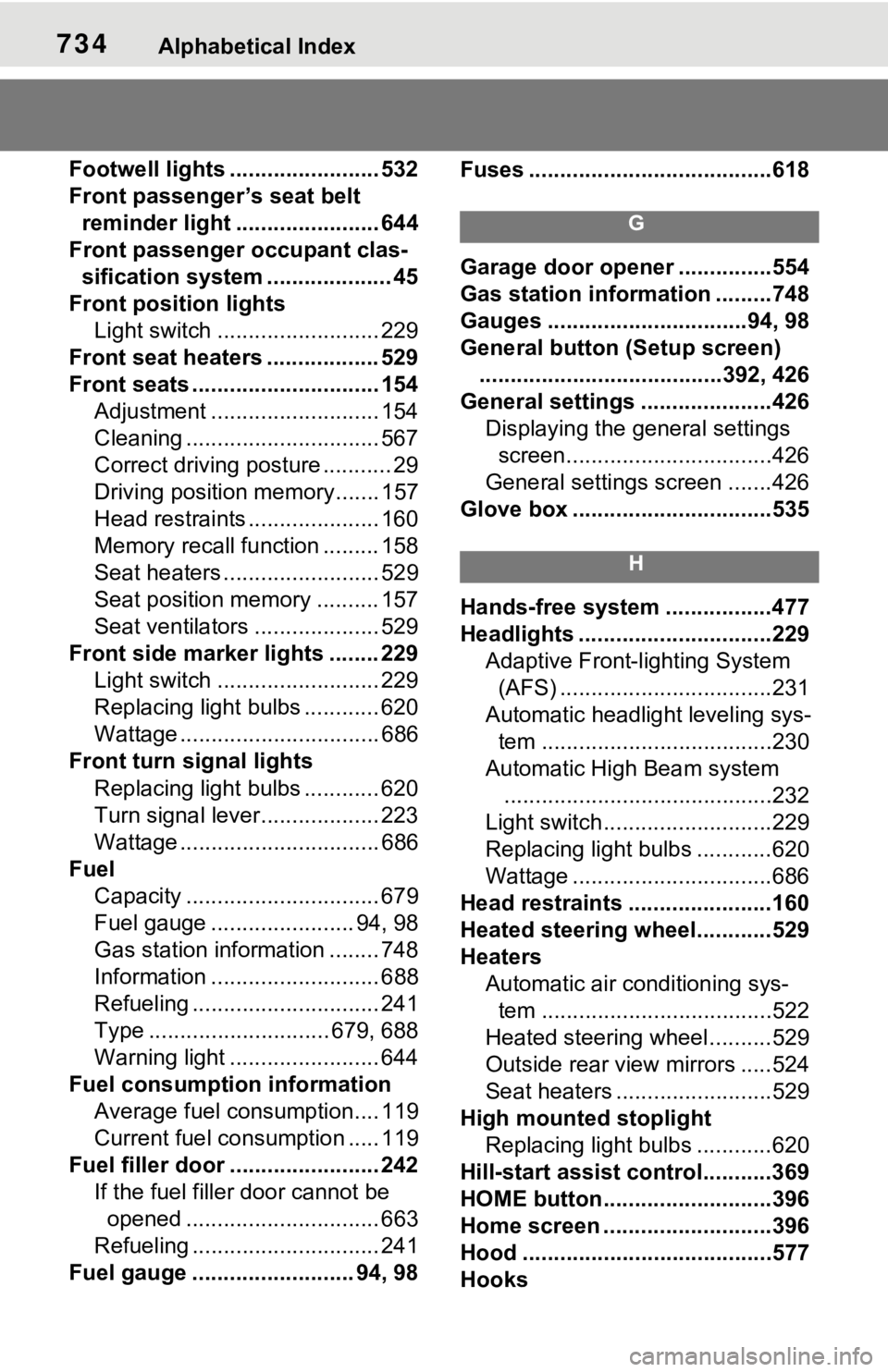
734Alphabetical Index
Footwell lights ........................ 532
Front passengerŌĆÖs seat belt reminder light ....................... 644
Front passenger occupant clas- sification system .................... 45
Front position lights Light switch .......................... 229
Front seat heaters .................. 529
Front seats .............................. 154 Adjustment ........................... 154
Cleaning ............................... 567
Correct driving posture ........... 29
Driving position memory....... 157
Head restraints ..................... 160
Memory recall function ......... 158
Seat heaters ......................... 529
Seat position memory .......... 157
Seat ventilators .................... 529
Front side marker lights ........ 229 Light switch .......................... 229
Replacing light bulbs ............ 620
Wattage ................................ 686
Front turn signal lights
Replacing light bulbs ............ 620
Turn signal lever................... 223
Wattage ................................ 686
Fuel Capacity ............................... 679
Fuel gauge ....................... 94, 98
Gas station information ........ 748
Information ........................... 688
Refueling .............................. 241
Type ............................. 679, 688
Warning light ........................ 644
Fuel consumption information Average fuel consumption.... 119
Current fuel consumption ..... 119
Fuel filler door ..... ................... 242
If the fuel filler door cannot be opened ............................... 663
Refueling .............................. 241
Fuel gauge .......................... 94, 98 Fuses .......................................618
G
Garage door opene
r ...............554
Gas station information .........748
Gauges ................................94, 98
General button (Setup screen) .......................................392, 426
General settings .....................426 Displaying the general settings screen.................................426
General settings screen .......426
Glove box ................................535
H
Hands-free system .................477
Headlights ...............................229 Adaptive Front-lighting System (AFS) ..................................231
Automatic headlight leveling sys- tem .....................................230
Automatic High Beam system ...........................................232
Light switch...........................229
Replacing light bulbs ............620
Wattage ................................686
Head restraints .......................160
Heated steering wheel............529
Heaters Automatic air conditioning sys-tem .....................................522
Heated steering wheel..........529
Outside rear view mirrors .....524
Seat heaters ....... ..................529
High mounted stoplight Replacing light bulbs ............620
Hill-start assist control...........369
HOME button...........................396
Home screen ...........................396
Hood ........................................577
Hooks
Page 748 of 748
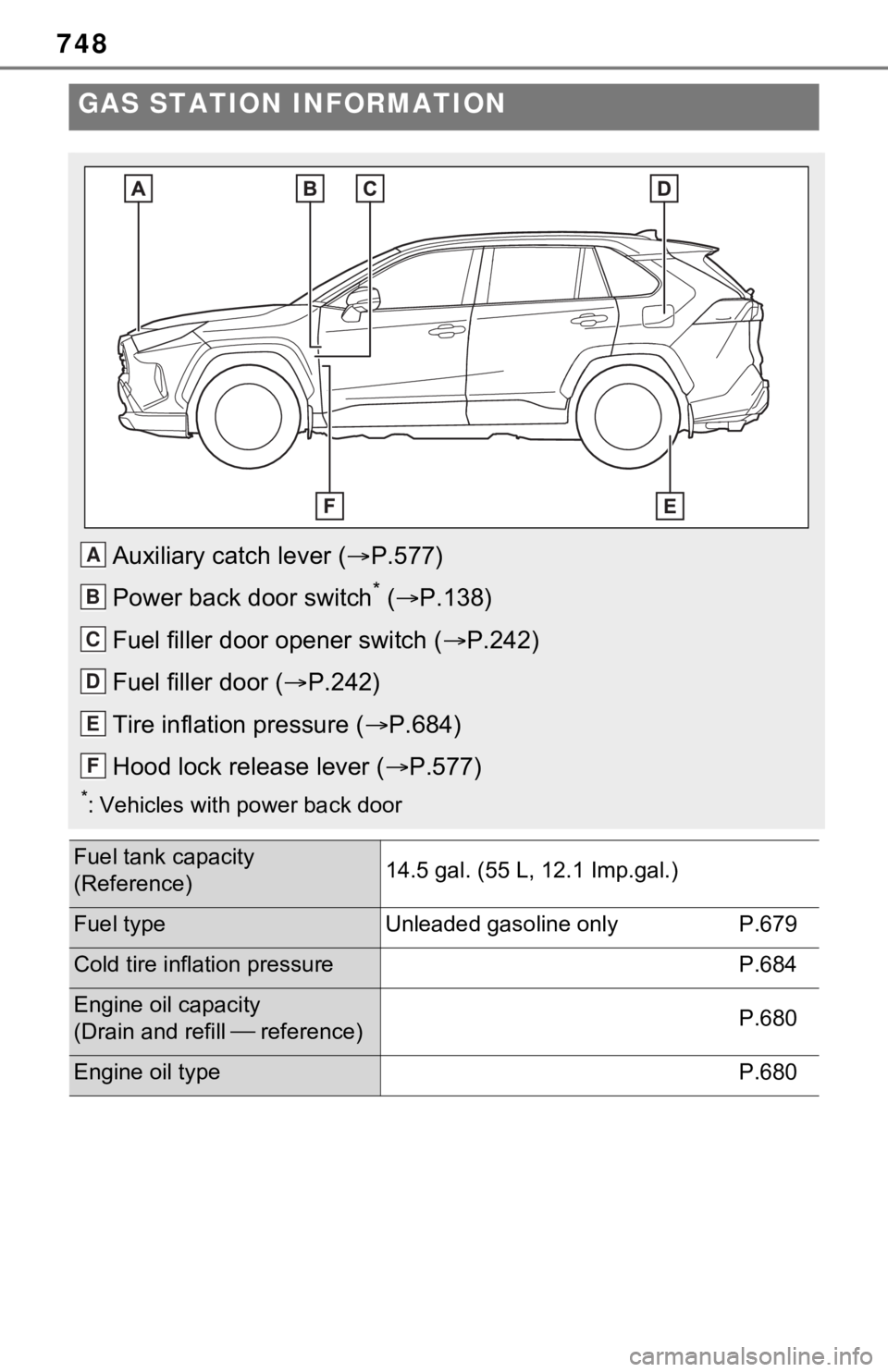
748
GAS STATION INFORMATION
Auxiliary catch lever (’é«P.577)
Power back door switch
* ( ’é« P.138)
Fuel filler door opener switch ( ’é«P.242)
Fuel filler door (’é« P.242)
Tire inflation pressure ( ’é«P.684)
Hood lock release lever ( ’é«P.577)
*: Vehicles with power back door
Fuel tank capacity
(Reference)14.5 gal. (55 L, 12.1 Imp.gal.)
Fuel typeUnleaded gasoline onlyP.679
Cold tire infl ation pressureP.684
Engine oil capacity
(Drain and refill ’éŠ reference)P.680
Engine oil typeP.680
A
B
C
D
E
F